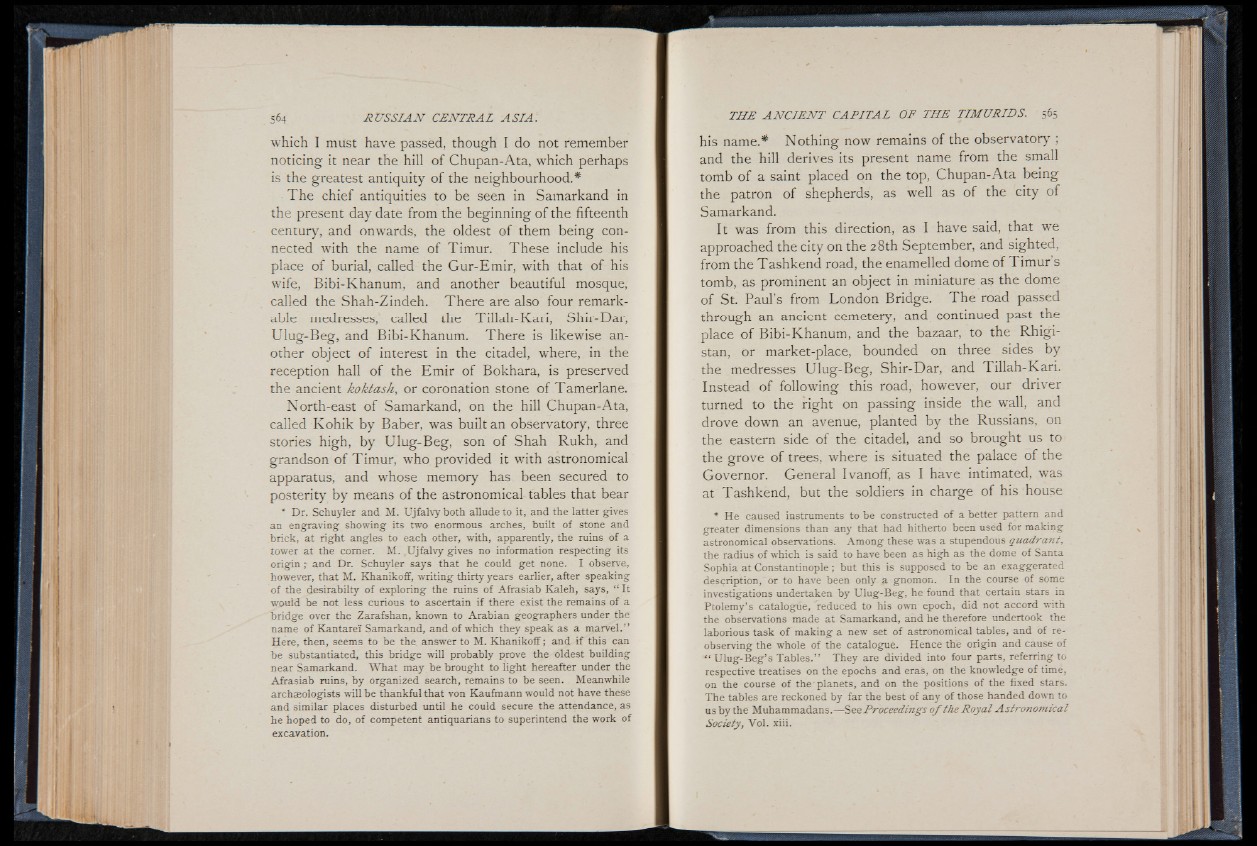
which I must have passed, though I do not remember
noticing it near the hill of Chupan-Ata, which perhaps
is the greatest antiquity of the neighbourhood.*
The chief antiquities to be seen in Samarkand in
the present day date from the beginning of the fifteenth
century, and onwards, the oldest of them being connected
with the name of Timur. These include his
place of burial, called the Gur-Emir, with that of his
wife, Bibi-Khanum, and another beautiful mosque,
called the Shah-Zindeh. There are also four remarkable
medresses, called the Tillah-Kari, Shir-Dar,
Ulug-Beg, and Bibi-Khanum. There is likewise another
object of interest in the citadel, where, in the
reception hall of the Emir of Bokhara, is preserved
the ancient koktash, or coronation stone of Tamerlane.
North-east of Samarkand, on the hill Chupan-Ata,
called Kohik by Baber, was built an observatory, three
stories high, by Ulug-Beg, son of Shah Rukh, and
grandson of Timur, who provided it with astronomical
apparatus, and whose memory has been secured to
posterity by means of the astronomical tables that bear
* Dr. Schuyler and M. Ujfalvyboth allude to it, and the latter gives
an engraving showing its two enormous arches, built of stone and
brick, at right angles to each other, with, apparently, the ruins of a
tower at the comer. M. Ujfalvy gives no information respecting its
o r ig in ; and Dr. Schuyler says that he could get none. I observe,
however, that M. Khanikoff, writing thirty years earlier, after speaking
of the desirabilty of exploring the ruins of Afrasiab Kaleh, says, “ It
would be not less curious to ascertain if there exist the remains of a
bridge over the Zarafshan, known to Arabian geographers under the
name of Kantarel Samarkand, and of which they speak as a marvel.”
Here, then, seems to be the answer to M. Khanikoff; and if this can
be substantiated, this bridge will probably prove the oldest building
near Samarkand. What may be brought to light hereafter under the
Afrasiab ruins, by organized search, remains to be seen. Meanwhile
archaeologists will be thankful that von Kaufmann would not have these
and similar places disturbed until he could secure the attendance, as
he hoped to do, of competent antiquarians to superintend the work of
excavation.
his name.* Nothing now remains of the observatory ;
and the hill derives its present name from the small
tomb of a saint placed on the top, Chupan-Ata being
the patron of shepherds, as well as of the city of
Samarkand.
It was from this direction, as I have said, that we
approached the city on the 28th September, and sighted,
from the Tashkend road, the enamelled dome of Timur s
tomb, as prominent an object in miniature as the dome
of St. Paul’s from London Bridge. The road passed
through an ancient cemetery, and continued past the
place of Bibi-Khanum, and the bazaar, to the Rhigi-
stan, or market-place, bounded on three sides by
the medresses Ulug-Beg, Shir-Dar, and Tillah-Kari.
Instead of following this road, however, our driver
turned to the right on passing inside the wall, and
drove down an avenue, planted by the Russians, on
the eastern side of the citadel, and so brought us to
the grove of trees, where is situated the palace of the
Governor. General Ivanoff, as I have intimated, was
at Tashkend, but the soldiers in charge of his house
* He caused instruments to be constructed of a better pattern and
greater dimensions than any that had hitherto been used for making
astronomical observations. Among these was a stupendous quadrant,
the radius of which is said to have been as high as the dome of Santa
Sophia at Constantinople; but this is supposed to be an exaggerated
description, or to have been only a gnomon. In the course of some
investigations undertaken by Ulug-Beg, he found that certain stars in
Ptolemy’ s catalogue, 'reduced to his own epoch, did not accord with
the observations made at Samarkand, and he therefore undertook the
laborious task of making a new set of astronomical tables, and of re-
observing the whole of the catalogue. Hence the origin and cause of
“ Ulug-Beg’ s Tables.” They are divided into four parts, referring to
respective treatises on the epochs and eras, on the knowledge of time,
on the course of the planets, and on the positions of the fixed stars.
The tables are reckoned by far the best of any of those handed down to
us by the Muhammadans.— See Proceedings o f the Royal Astronomical
Society, Vol. xiii.